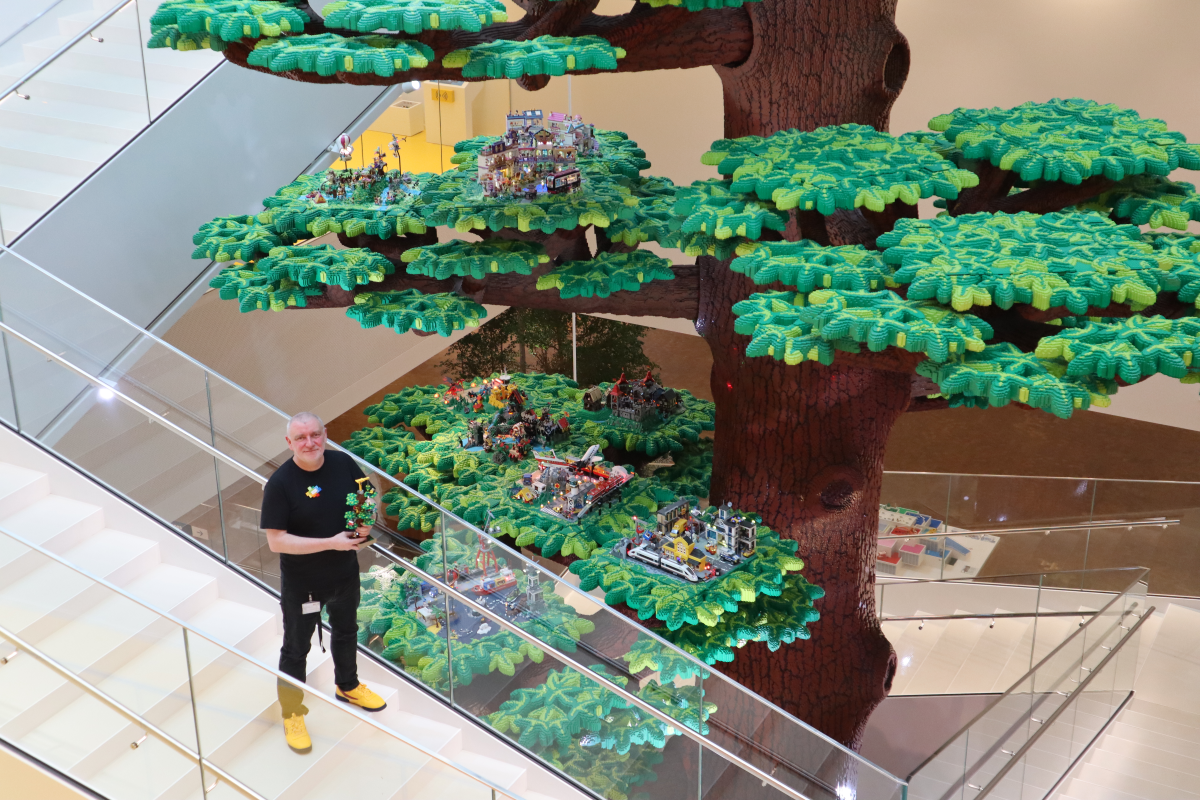While at BricksCascade this year, I had the pleasure of interviewing Senior LEGO designer Stuart Harris.
Mr. Harris has been with LEGO for over 15 years and currently works on the installations at the LEGO house in Billund, Denmark.

Note: This interview has been lightly edited for clarity.
GeekDad Sean:
How did you get your position at LEGO? Is your background in product design, or as a casual builder?
Harris:
Well, actually, I did formally train as a designer and I’ve always kind of worked in this industry, or really I’ve worked in the toy industry or the business through experience industry, and my career within LEGO started as a model builder, model designer, for LEGOLAND Windsor back in 1993.
Sean:
As a designer of these pieces, could you talk us through the actual design process? Is it, start with sketches and then go through a CAD program into a completed thing? Is it lots of people proposing their own ideas and building mock-ups? What does it look like?
Harris:
It’s one of those how long is a piece of string kind of thing, because it varies on what you’re doing. When we do one of the big models, like where I am now in the LEGO House, we have some quite iconic huge models in there. We have something called The Tree of Creativity, which is this 50ft, 15 and a half meter tall LEGO model tree, and something like that goes through quite a number of design stages. Yes, we will start with sketches, or actually we start with a mood board of ideas and the tone of voice that we’re going for, and then we start sketching it up and then we start moving into some very basic CAD models, just to mass the model out. Then we start working with our own special proprietary software, where we start detailing up in LEGO bricks and working up that. But, at the same time as doing stuff in CAD, we’ll also build prototypes, because no matter how good the CAD is, you don’t get a real feel for it until you actually start building something. For example, when we built the tree, we built the bark as a prototype so we could decide the level of detail and intricacy we were going to go for.

Sean:
On those large scale models, are those completely held up with LEGO, or do they have to have some kind of internal scaffolding?
Harris:
They’re all built by hand using normal LEGO bricks, but for safety reasons when we’re building something very, very large, then we’ll put maybe a steel pipe down the middle of the thing to make sure that we don’t knock it over and we have to build it again. We’ll glue it, and we’ll also support it with some steel if it’s going to be a long term permanent piece.
Sean:
For something that huge, are the pieces assembled in the LEGO House, or are they assembled offsite?
Harris:
We actually have a couple of different sort of model shops around the world, and the one we used for LEGO House is in a city called Kladno, which is just outside Prague, which is our main European model shop. All the large scale models were built there, that’s where a lot of the talent is and a lot of the facilities to be able to build these giant models. We have a couple of hundred people, model builders working there, and actually, while we were doing the models for LEGO House, it was actually a 24-hour operation.
It was working on three shifts to build all these models because there are thousands and thousands of hours which go into building some of these large scale models, so we’re working very closely with the model shop in the Czech Republic to build these models. They build them offsite, if you like, they build them in the Czech Republic, and then they put them in lorries and drive them up to the LEGO House, and that’s where we assemble them.
Something like the tree, The Tree of Creativity, which is a huge model, we didn’t have anywhere big enough to assemble it, to test assemble it in the Czech Republic, so actually, the first time we saw it fully assembled was in the LEGO House.
Sean:
So I assume it is more common that you’d see at least a full prototype in the build lab in the Czech Republic before you actually have to transport it?
Harris:
That’s right. Most normal scale models you would see in full size and fully assembled before they ship it.
Sean:
How does designing a model for the house, that’s an installation piece, differ from building a consumer set?
Harris:
Obviously scale is one thing, and usually it’s going to be a one-off, the one-off kind of thing. You’re not designing something also to be built by consumers, so it’s going to be built by professional model builders. It is a very, very different design process, we’re not going through the same build testing that we would do with a set that we would be selling in the stores.
Sean:
Can you tell us a little bit about that kind of testing? Like are there requirements of how many pieces you have, or the complexity? How do you set those rules?
Harris:
There are a number of different criteria you have to work with when designing sets. I do design some sets, but not as much as I do the big models, but I have done a few and it’s much more about making sure that it’s a great building experience when you’re designing a set for a consumer. We have our own quality standards in terms of making sure that it’s appropriate for the age level, that the piece count matches the price point that we’re aiming at, and so on. There are a number of different criteria we have to work with, which form the design constraints for the model.
Sean:
When you’re designing one of those models for an existing thing, like a piece of architecture for your architecture sets, or for a licensed property, for example, how do you determine scale?
Harris:
Some of the stuff that I do is more of the limited edition kind of exclusive sets, and there it varies what the model is. For example, a couple of years ago I was working with designing a tractor, and for that, you look for a starting point, and for me, the starting point was the wheels and the tires because that was going to determine the scale. Finding something which was sort of the right wheel and tire then determined the rest of the model.
Sean:
One thing that you mentioned at a panel earlier was the LEGO green brick initiative, and changing of sourcing of the plastics. Could you talk a little bit about that?
Harris:
I’m not an expert in it, but it’s certainly something that we have a large team of guys working on this in terms of finding sustainable materials to make the LEGO bricks. It’s very important for us that they meet the same quality standards that we have with the existing bricks, and we’re trying different things out as to what was going to be best as a long term solution.

Sean:
There are lot of fan works are showcased at the LEGO House. How do you choose not just what creations to highlight individually, but what themes you’re going to display? How does that review process work?
Harris:
Well, there are a number of different areas within the house where we have fan content. For example, in what we call The Masterpiece Gallery, that’s the main showcase in the LEGO House where we showcase the work of fans. There, we ask the LEGO ambassador network to make a list of nominated potential exhibitors and they will send us a list of, each ambassador will send us a list of five or six names with their portfolios, and then I’ll go through all those different portfolios, and it’s more about putting a collection together which represents the community as it is. Try and get as many different geographic regions represented, as many different styles represented.
Then we have other areas in the House, so, for example, we have these wall cases within the different zones. In the yellow zone, we have a wall case which is themed around nature, and there we sort of open source it, so we actually made a public competition to send in ideas, and from those competition entries, we made a selection.
Sean:
I just have one final questions, and I’m sure this is a really common question for you but I have to ask: of all the models you’ve worked on over the years, what’s the one that you’re most proudest of, or you find the most memorable?
Harris:
Yeah, I get that question a lot, and it’s a really tough one. The way I like to answer it is, it’s like choosing your favorite child. It’s so difficult and so tough to make a choice when you’re looking at all those models which you’ve put so much brick, sweat and tears into. But I think obviously one that does stand out is The Tree of Creativity, that was quite groundbreaking in terms of the model and the scale and the design process that we went through with that.
Sean:
That is everything. Thank you so much for your time.
Harris:
No problem at all.
If you’d like to learn more about the Tree of Creativity, or about the LEGO House, the documentary LEGO House: Home of the Brick is available on Netflix.






Great interview Sean! I’d love to get to the LEGO House someday or even be able to go to a fan convention.
Those Lego dinos are amazing!